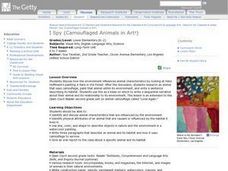Berkshire Museum
Camouflage!: Collecting Data and Concealing Color
Help young scholars see the important role camouflage plays in the survival of animals with a fun science lesson. Starting with an outdoor activity, children take on the role of hungry birds as they search for worms represented by...
Curated OER
Camouflage
Here is a lesson which incorporates ingenious hands-on activities that simulate how many animals use camouflage as a survival technique. This lesson clearly outlines how to implement the activities and discussion sessions found in it....
Curated OER
Camouflage
First graders learn how plants and animals adapt to their environments. In this camouflage lesson, 1st graders watch a movie that explains animal camouflage, design a butterfly that blends into a classroom habitat, create a mini book...
Curated OER
Survival Strategies and Adaptation in Insects
Third graders investigate insects and their adaptations that help them survive. In this survival strategies lesson, 3rd graders view photographs of insects and discuss the adaptations that each one uses to survive, including camouflage...
Virginia Department of Education
Adaptation and Evolution
Um may be the atomic symbol for confusion, but it won't be needed in this instructional activity. Scholars rotate through seven stations completing experiments, hands-on activities, writing exercises, and analysis. Stations include...
Curated OER
Animal Camouflage
Students investigate how animals adapt to their environment. In this animal science lesson, students participate in an experiment using patterned paper and plain paper to simulate how animals blend into their surroundings. Students...
Curated OER
Week 7: Animal Adaptations - Bird Beaks
Learners use tools to represent bird beaks and pick up different types of food with them in order to discover which beak would help the bird survive depending on their food type.
Curated OER
Feeding Frenzy
Young biologists take a look at the myriad of ways that animals increase their chances of surviving in the wild. The adaptations help animals hide, hunt, and attract a mate. This lesson specifically explores how insect mouth parts are...
Curated OER
I Spy (Camouflaged Animals in Art!)
Make connections about animal characteristics and the animal's environment. In this animal characteristics lesson, students use a piece of art as a springboard for a discussion about animals and camouflage. Students choose an animal that...
Curated OER
Awesome Adaptations!
Second graders explore biology by researching animal characteristics. In this adaptation lesson, 2nd graders identify the history of several animals and research the changes that have occurred to their anatomy over thousands of years....
Curated OER
Animal Adaptations
Students use items from boxes to dress up classmates as animals adapted to a given environment.
Curated OER
Create a New Animal
Students understand what physical adaptations are and how they help an animal to survive. In this adaptations lesson, students research four animals and then make an original animal that has adaptations to make them survive.
Curated OER
Structural and Behavioral Adaptations
Learners participate in a role playing lab that allows students to experience how different beak adaptations play a role in the type of food the animal can eat, therefore playing a role in the survival of the species.
Curated OER
How Organisms Live Successfully in Their Environments
Students compare the climate and organisms found in different environments, then give examples of how plants and animals adapt to their environment. They design an animal who adapts using camouflage to a made-up environment.
Curated OER
Animal Camouflage 1
Second graders work in groups and they are asked to line up on either side of the board. They are explained that on the teachers instruction, one student at a time runs to the marked area and brings back the first worm they see. Students...
Curated OER
Wildlife
First, biology pupils research land and marine habitats along the route of skipper Rich Wilson's Great American II. Then, using colored paper clips scattered across a colored paper background, they play the predator-prey game to...
Curated OER
Animal Hide and Seek
Students read about animal camouflage. In this animal adaptation lesson, students read short texts about ways in which animals hide or transform to escape their prey. Students explore animal classifications and determine ways to hide in...
Curated OER
Camouflage, Protection, & Adaptations—Who am I?
Students explore ocean animal adaptations. In this animal adaptations lesson, students examine how different ocean animals use adaptations other than camouflage to protect themselves.
Curated OER
Adaptations
Learners are able to describe protective adaptations of animals. They are able to categorize the animals based on their protective adaptations. Students discuss adaptations of animals. They are explained that an adaptation helps an...
Curated OER
Guess Who?
Getting ready for a lesson on animal adaptations can be a lot of fun. Kindergartners will go on an egg hunt. Once they have collected all the eggs, they will open them up to reveal an image of an animal. Each pupil will act out their...
Curated OER
Wildlife
The centerpiece of this lesson plan is a predator-prey simulation in which colored paperclips represent different species of animals camouflaged against a colored background. Relevant follow-up questions are provided. The activity is...
Curated OER
Who Lives with Mallard?
Young scholars color a picture of the habitat featuring mallard and other creatures, some of whom might be camouflaged or half-hidden. They discuss other forms of animal adaptation.
Curated OER
Dull Duck, Dashing Duck
Students learn about animal camouflage. In this animal adaptations instructional activity, students discuss the patterns and adaptations animals use to help them survive, discuss the uses of camouflage, visit a local wetland if...
Curated OER
Finding Caterpillars
Learners examine how animals protect themselves from predators and camouflage themselves. They participate in a simulation in which they locate red and green yarn "caterpillars," organize their data, and generate a bar graph using...

























